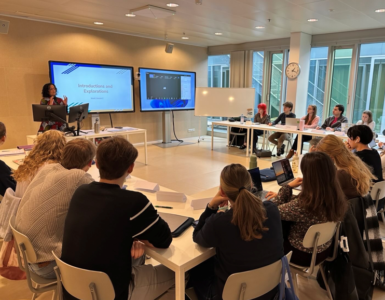As part of my survey of the video research landscape reported on in a previous article in this newsletter, I’ve been working on ways of translating these into a practical framework that could be used to address real questions people producing or commissioning instructional videos have.
The most commonly cited are Mayer’s 12 Principles of Multimedia Learning and Koumi’s pedagogic principles. While these provide valuable insights, in practice they leave many questions unanswered. Also, as I discussed in my previous article, they do not reflect the full range of video learning experiences available in the instructional video landscape today.
In response to this need, I created a shorter more concise framework to help both create and evaluate effective instructional videos. This framework is formulated from the perspective of 6 tasks a video needs to achieve. These are:
- Direct attention
- Minimise distraction
- Support conceptualisation
- Make a personal connection
- Enable navigation and give learner control
- Balance competing needs based on the learner’s situation
I presented this framework at the Online Media & Learning Conference 2020 recently and would like to share it here to receive more feedback. It is still very much a work in progress but I believe that it has some advantages over Mayer’s 12 principles by at the same time filling in the gaps left by that framework and simplifying the list to make it easier to remember for practitioners (albeit at the risk of some overlap). I outline the mappings to the principles with each task. Unlike Koumi’s framework, these tasks focus more on the production features of the video rather than the structure of its presentation.
What all these frameworks (including the list of best practices by Brame I mentioned in my previous article) have in common is attention to the context of learning in which the videos are placed and do not think of the video as either necessarily the start or the end of the learning process. The 6 tasks framework makes that even more explicit by devoting 2 items to different aspects of the context.

Task 1. Direct attention
The video needs to help viewers know what to pay attention to and keep a clear distinction between different attention spaces.
- Always have pointers to what you’re talking about
- Have descriptions and images close to each other
- Don’t talk over a slide with 6 bullets – break down each bullet into a separate slide
Applicable principles: Signalling principle, Spatial and Temporal Contiguity principles
Task 2: Minimise distraction and support processing
There is only so much that the viewer can keep in their working memory. Don’t introduce elements in the video that will overload their ability process and integrate.
- Only use relevant illustrations and images
- Avoid decorative images without purpose (even logos on every slide)
- Avoid unnecessary animation
- Don’t use side notes and anecdotes
- Don’t display large amounts of text and talk at the same time
- Simplify graphics to only contain relevant information and focus on what is important
- Crop into images to focus on what is important, reduce extraneous elements
Applicable principles: Coherence principle, Redundancy principle, Modality principle
Task 3: Support conceptualisation and integration
Learning from video requires integrating new information presented with what the user already knows. Introduce elements that will support the viewer’s ability to make sense of what is being presented. Often this cannot be achieved by a single video. Think in terms of the whole sequence of learning.
- Explain only one new concept at a time in a video or a navigable segment of a video
- Make sure viewers understand all new or difficult words – start with a quick definition or provide a list before the video
- Start with a brief summary of the video’s purpose
- Prime viewers’ expectations with examples they can relate to
- Illustrate concepts with relevant graphics and images
- Use icons to help differentiate lists
- Present videos in such a way that viewers can control how they access the information
Applicable principles: Multimedia principle, Pre-training principle
Task 4: Make a personal connection
People learn best when they feel that they have a connection with the teacher. Make videos and other materials that directly address the user and that come from you as a human being talking to another. Make it clear that you understand who is watching the video. Don’t think in terms of corporate video production, or TV which speaks to a much broader audience.
- Address the viewer directly, use ‘you’
- Include the face of the speaker
- Speak in a natural voice – don’t overenunciate or slow down, slightly faster delivery is better than too slow
- Don’t use a script unless you’ve taken the time to write it to sound natural and practiced reading it
- Don’t try to compress ideas too much just to keep the video short, give examples, explain why things are relevant
- Give personal examples but be careful about too many digressions or anecdotes
Applicable principles: Personalisation principle, Voice principle
Task 5: Enable navigation and give learners control
Learners accessing videos or any other learning materials approach them strategically. They need to have a quick way of getting the gist and a quick way of returning to specific parts. This is more difficult with video than with text. Enable your viewers to control the pace and the sequence.
- Only one video per topic
- Videos between 5-15 minutes OR videos with links to be able to jump to video sections
- Don’t make videos that are too short just for the sake of it. If the video is just 1 minute long, there’s a good chance, a written paragraph or bullet list would be better.
- Pay attention to how the video is presented to students (can they pause, jump around)
- Present information in small chunks
- Number lists for reference
- When available, provide an automatic transcript – let students download it. If possible, let them use it to navigate the video.
- Don’t use pre-roll credits – the first thing the viewer should see is what the video is about – not who made it or what series it is part of
- Let students download the videos, if possible, to watch off line.
Applicable principles: Segmenting principle, Pre-training principle
Task 6: Balance competing needs based on the learner’s situation
Always take the situation of the learner into account when balancing the competing demands of these principles. For example, complete beginners accessing very technical subjects may have very different demands from intermediate learners or even experts who have much more subject expertise to draw on.
Many of the tasks of the instructional video conflict with each other. For example:
- Beginners need much more chunking and reducing the demands of cognitive processing. This means – shorter, less discursive videos with fewer examples.
- Having a face in the video makes it easier to build a personal connection but it also introduces a distracting element. Very technical subjects aimed at beginners may benefit from no face if the students know the instructor or switching between the face and the subject.
- Introducing anecdotes or additional visual elements may provide additional processing load but may make it easier to make a personal connection or to link the new concept with prior to knowledge.
References
The complete list of references I drew on is available here.

Author
Dominik Lukes
Digital Learning Technologist, Saïd Business School, University of Oxford, UK














